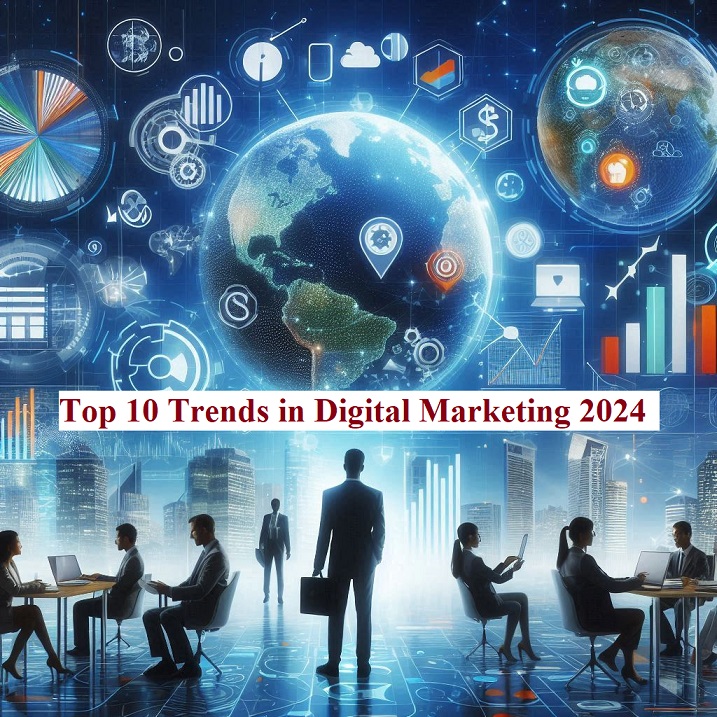Digital marketing allows businesses to reach a much larger and more targeted audience compared to traditional marketing methods. With billions of people using the internet daily, businesses can leverage various digital channels to engage with their target demographics. the key benefits of focusing on digital marketing in 2024 are its unparalleled reach, cost-effectiveness, measurability, engagement capabilities, and the competitive advantage it provides businesses of all sizes. Developing a robust digital marketing strategy is crucial for success in the modern business landscape.
-
Strategy
Developing a digital marketing strategy that generates business outcomes is key to success, as the average tenure of CMOs at Fortune 500 companies was just 4.2 years in 2023.
-
Generative AI
AI tools like ChatGPT are disrupting the industry, with predictions that AI will change how consumers behave, purchase, and how businesses operate.
-
AI-Driven Conversational Marketing
80% of customers now anticipate AI-powered interactions to significantly elevate their service experiences, with AI-enabled chatbots revolutionizing customer interactions.
-
Augmented Reality (AR)
The AR market is forecasted to grow from $25.1 billion in 2023 to $71.2 billion by 2028, as brands increasingly merge the digital and real worlds.
-
Sustainability and Ethical Practices
78% of US consumers deem a sustainable lifestyle important, so transparency, authenticity, and ecological responsibility are becoming fundamental for brands.
-
Hyper-Personalization
Modern consumers seek tailored experiences, so brands are harnessing big data and analytics to develop hyper-personalized marketing strategies.
-
Mobile-First Marketing
With 188.9 million cellular mobile connections in Pakistan at a 77.8% penetration rate, optimizing for mobile is mandatory.
-
E-commerce Boom
The e-commerce sector is booming in Pakistan, so marketers must focus on optimizing online shopping experiences.
-
Video Content Dominance
Video content remains king, with platforms like YouTube and TikTok driving engagement, so marketers should invest in high-quality video production.
-
Influencer Marketing
Influencer collaborations are more effective than ever, offering authenticity and trust to brand messaging.
The Key Benefits of Focusing on Strategy over Technology in 2024
Focusing on strategy over simply implementing the latest technologies allows organizations to derive maximum business value from their technology investments and stay ahead of the competition in 2024 and beyond.
-
Alignment with business objectives
Developing a strategic technology plan that is directly linked to the organization’s overall business goals ensures that technology investments support and enable the achievement of those objectives.
-
Long-term vision
A well-defined technology strategy helps develop a long-term business vision by anticipating future organizational needs and market/competitive dynamics.
-
Increased operational efficiency
Aligning technology with strategic priorities can improve employee productivity, customer experiences, and team collaboration through the right technology solutions at the right time.
-
Competitive advantage
A thoughtful technology strategy that is integrated with the business strategy can provide a competitive edge by enabling the organization to be more agile, innovative, and responsive to market changes.
-
Risk management
A strategic approach to technology helps identify and mitigate risks related to data privacy, security, and ethical AI implementation, which are growing concerns with the rise of technologies like generative AI.
The Risks of Prioritizing Technology over Strategy
While investing in the latest technologies is important, it should be done within the context of a well-defined digital strategy that is closely aligned with the organization’s overall business objectives and priorities. Prioritizing technology over strategy can lead to wasted resources, increased risks, and missed opportunities for sustainable growth and innovation.
-
Misalignment with business objectives
Investing in technologies without a clear strategic plan can lead to wasted resources and missed opportunities to drive business growth and innovation.
-
Short-term focus
Chasing the latest trends in technology without considering long-term implications can create a reactive, unsustainable approach to technology management.
-
Increased security risks
Implementing new technologies without proper risk assessment and mitigation strategies can expose the organization to cyber threats and data breaches.
-
Operational inefficiencies
Deploying technologies that are not well-integrated with existing systems and processes can hamper productivity, collaboration, and customer experiences.
-
Competitive disadvantage
Failing to develop a forward-looking technology strategy that anticipates market changes and evolving customer needs can put the organization at a competitive disadvantage.
-
Lack of agility
Rigid technology infrastructure that is not adaptable to changing business requirements can make the organization less responsive to new opportunities and challenges.
-
Talent challenges
Attracting and retaining top technology talent becomes more difficult without a compelling vision and roadmap for how technology will enable the organization’s strategic goals.
